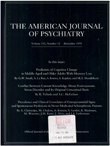Somatization and the recognition of depression and anxiety in primary care
Abstract
OBJECTIVE: The authors examined the effect of patients' style of clinical presentation on primary care physicians' recognition of depression and anxiety. METHOD: The subjects were 685 patients attending family medicine clinics on self-initiated visits. They completed structured interviews assessing presenting complaints, self- report measures of symptoms and hypochondriacal worry, the Diagnostic Interview Schedule (DIS), and the Center for Epidemiologic Studies Depression Scale (CES-D). Physician recognition was determined by notation of any psychiatric condition in the medical chart over the ensuing 12 months. RESULTS: The authors identified three progressively more persistent forms of somatic presentations, labeled "initial," "facultative," and "true" somatization. Of 215 patients with CES-D scores of 16 or higher, 80% made somatized presentations; of 75 patients with DIS-diagnosed major depression or anxiety disorder, 76% made somatic presentations. Among patients with DIS major depression or anxiety disorder, somatization reduced physician recognition from 77%, for psychosocial presenters, to 22%, for true somatizers. The same pattern was found for patients with high CES-D scores. In logistic regression models education, seriousness of concurrent medical illness, hypochondriacal worry, and number of lifetime medically unexplained symptoms each increased the likelihood of recognition, while somatized presentations decreased the rate of recognition. CONCLUSIONS: While physician recognition of psychiatric distress in primary care varied widely with different criteria for recognition, the same pattern of reduction of recognition with increasing level of somatization was found for all criteria. In contrast, hypochondriacal worry and medically unexplained somatic symptoms increased the rate of recognition.
Access content
To read the fulltext, please use one of the options below to sign in or purchase access.- Personal login
- Institutional Login
- Sign in via OpenAthens
- Register for access
-
Please login/register if you wish to pair your device and check access availability.
Not a subscriber?
PsychiatryOnline subscription options offer access to the DSM-5 library, books, journals, CME, and patient resources. This all-in-one virtual library provides psychiatrists and mental health professionals with key resources for diagnosis, treatment, research, and professional development.
Need more help? PsychiatryOnline Customer Service may be reached by emailing [email protected] or by calling 800-368-5777 (in the U.S.) or 703-907-7322 (outside the U.S.).



